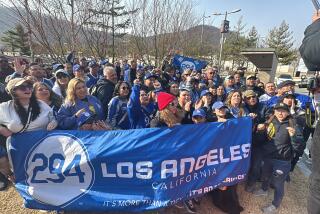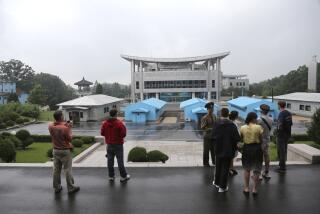Koreas’ DMZ Holds Visitors in Thrall
DEMILITARIZED ZONE, South Korea — Their business meetings over, Frank Dunn and Mark Dnistran went looking for a little fun on their last day in Seoul. They found it 25 miles away and about 240 feet underground, in a secret tunnel dug by the North Korean army.
A monorail delivered the two Americans and a handful of other tourists into the bowels of the Earth. There, in matching white hard hats, they paced part of the musty duct deep beneath the DMZ, the patch of land separating the two Koreas.
The experience was a bit much for Dunn -- but not because above him lay the most fortified border in the world. The narrow rock walls preyed on his mild claustrophobia.
“For me to point out how crumbly the walls were probably helped,” Dnistran offered.
“Yeah, that was reassuring,” Dunn shot back as the monorail rumbled to the surface and their ride ended.
This isn’t exactly Disneyland, in spite of the cheery decal on the monorail’s front car: a cutesy cartoon character clutching a heart, with the words “I love you” underneath.
But with the aplomb of enterprising people living under an armistice that has held for half a century, some South Koreans have succeeded in turning the DMZ -- once dubbed by former President Clinton as “the scariest place on Earth” -- into something of a tourist trap, if not the happiest place on Earth.
On any given day, American and South Korean soldiers in their fatigues patrol the area around the boundary line, guns ready, guarding against attack from the enemy to the north.
On any given day, tourists toting their own shooting gear -- for photos, that is -- also descend on the border, eager for a glimpse of the soldiers, the no-man’s land the troops monitor and the mountains of the hostile, isolated land across the divide.
Such sightseeing may seem out of place, given the serious business that goes on in the DMZ. This is, after all, the last frontier of the Cold War, a place where communism and the free world still stare at each other eye to eye, hoping the other will back down. Technically, the Korean War is not over, and the DMZ manifests that.
But given the relative peace, or at least lack of combat, of the last 50 years, the zone is safe to visit. Its status as a final outpost only adds to its appeal, which travel agencies have found can amount to serious business indeed. Last year, 150,000 people visited the DMZ, many of them paying $40 to $65 a pop, lured by a tantalizing mix of history, tragedy and lurking tension.
“It’s partially like people stopping to look at an accident,” said Dnistran, 41, of Valencia.
Because venturing into the DMZ and its surrounding area requires special permission, the tour groups that arrange the visits with the permission of U.S. and South Korean forces have a stranglehold on the market.
“A truly bizarre experience!” promises one brochure. The landscape may look pretty, the flier adds, but the discerning visitor can “imagine the death and disaster” that took place in the region.
“It’s one of the weirdest and most fascinating places you can reach,” the blurb concludes.
The visits attract all sorts, from Japanese tourists to returning American war vets.
Various rules for visiting heighten the sense of taboo, of being allowed a peek into a secret world of political intrigue and ideological confrontation.
The Dora Observatory viewing platform on the southern edge of the zone was built expressly for tourists to gawk at North Korea. Taking photos of the area across the border is strictly forbidden, even though all you see are bare hillsides.
Jeans are prohibited for visitors to Panmunjom, the site in the heart of the DMZ where the two Koreas signed their truce in 1953. The chief of the U.S. troops stationed there says the dress code is to maintain a respectful atmosphere, but others say it’s for fear that the North Koreans might snap photos of Westerners in their jeans -- which used to be considered lower-class garb in Korean society -- and turn them into propaganda showing the “poverty” of people under the yoke of capitalism.
Sandals, shorts, tight or see-through tops, and shaggy hair are also prohibited. And visitors are sternly warned not to touch any of the paraphernalia on the communist side of a carefully divided table in one of the Panmunjom conference rooms, where officials from the two sides occasionally sit down to meetings.
For the 38,000 U.S. soldiers in South Korea -- whose presence is increasingly resented in this country -- such tours have a certain public relations value: showing off the protection American troops provide from possible invasion.
The gravity of the situation, however, is undermined by outbreaks of kitsch and camp. Coin-operated binoculars at Dora Observatory allow tourists to scan the North Korean landscape as they might the Manhattan skyline from atop the Empire State Building. Shops hawk souvenirs, such as sweatshirts with the logo “Panmunjom -- Since 1953.”
Visitors mug for photos next to South Korean soldiers, who stand in taekwondo poses in order to look intimidating to North Korean troops and wear dark sunglasses to keep their expressions impassive.
“On the one hand we have this Disneyland mission, where ... these people go on tour and they buy a drink and then there’s a gift shop at the end of the bus ride,” said U.S. Army Capt. Brian Davis, who has been stationed in the DMZ for about a year. “But then we also have live-combat patrols, people with loaded weapons standing not three feet from soldiers of an opposing force from a country they’re still technically at war with.”
Most incongruous, perhaps, is a small theme park near an entrance to the DMZ.
There, visitors waiting to take buses into the border zone can while away the time on bumper cars or the Super Viking, a pendulum-style ride.
“I’m very ashamed,” said Rose Chi, a South Korean tour guide. “This is such a significant place. I don’t know why our government put up something like this.”
More to Read
Sign up for The Wild
We’ll help you find the best places to hike, bike and run, as well as the perfect silent spots for meditation and yoga.
You may occasionally receive promotional content from the Los Angeles Times.







